
Parangal at pasasalamat [recognition and thanksgiving]” with “Science for the People [SFTP] Awards” was the highlight of the 64th anniversary celebration of the Department of Science and Technology (DOST) as it acknowledged its partners in delivering science, technology and innovation (STI) to the people.
At the same time, the event served as the appreciation night of Science Secretary Fortunato T. de la Peña for DOST’s partners during his helm as he winds up his term at the department that ends on June 30.
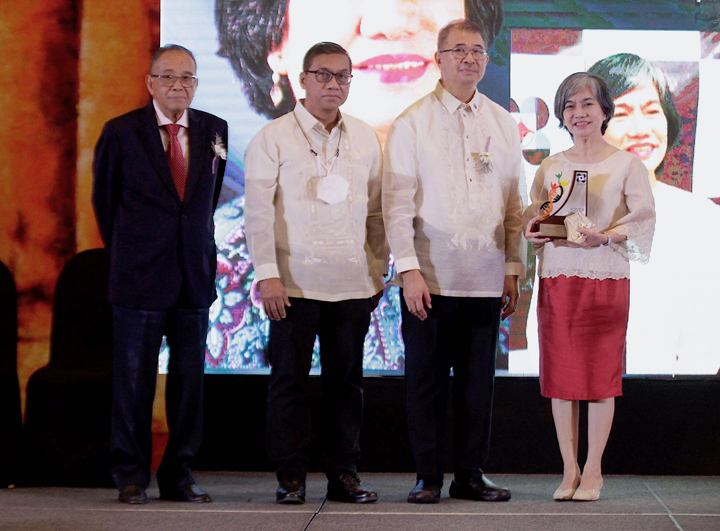
The DOST gave SFTP Awards to its outstanding partners from different sectors to express its gratitude in advancing STI.
The Business Mirror was among the recipients of two SFTP Awards for the Media. The Institution category was received by its Editor in Chief Lourdes M. Fernandez, while the Individual category was given to Science Editor Lyn B. Resurreccion.
The Vaccine Expert Panel, that was led by Dr. Nina Gloriani, was among the top SFTP awardees for its invaluable contribution in the review of vaccines for Covid-19 and development of criteria for the procurement of vaccines for emergency use in the country.
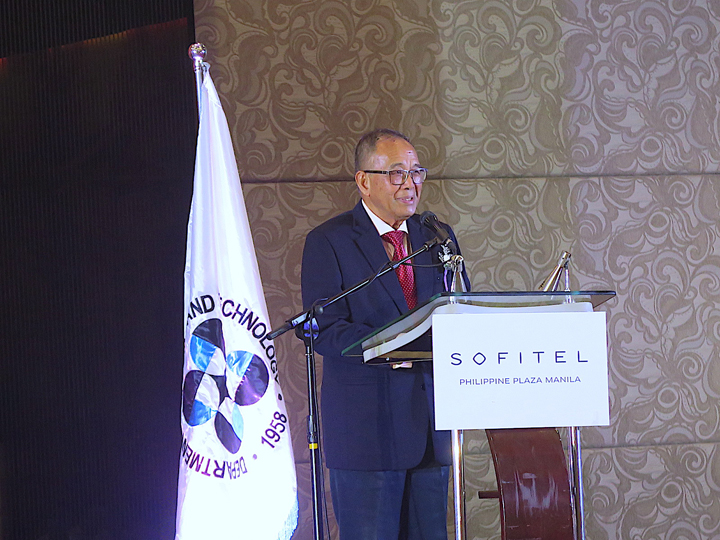
Also awarded were the DOST outstanding partners from the higher education institutions, industry, local government units, science and technology foundations, national government agencies, bilateral diplomatic partners, policy-makers, nongovernment organizations.
SFTP Awards were likewise bestowed to the S&T sector in research and development projects, technology commercialization, start-ups, enterprise productivity, community development, DOST governance innovations.
Gender and Development Awards were also given.
At the same time, former DOST assistant secretary Dr. Lydia Tansinsin, launched her book on the history of the DOST titled, “An Institutional Journey: From the NSDB to the DOST, 1958-1998.”
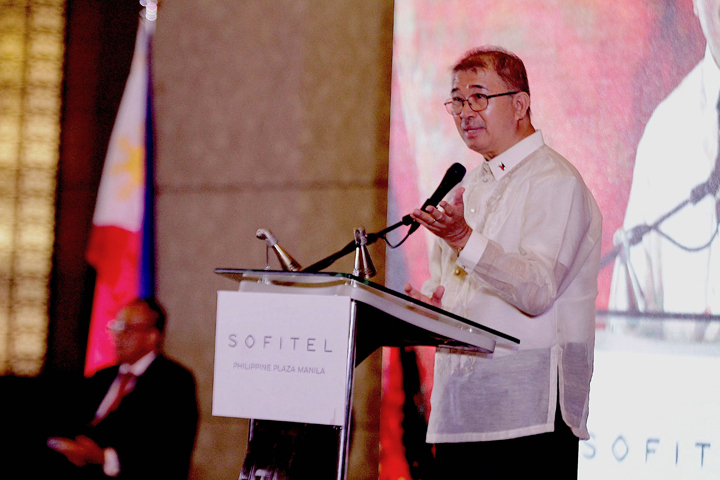
Best in performance; practice meritocracy
In his keynote address, National Scientist Dr. Emil Q. Javier said, being a former secretary of DOST, he takes pride in the department’s having been consistently rated “among the best in terms of quantity, quality and timeliness in its performance.”
At the same time, he said DOST has always have the impression of “meritocracy bereft of corruption” among all agencies in government.
Javier highlighted three remarkable achievements of the DOST under the helm of de la Peña.
One is the mitigation of the loss of lives and properties from the calamities due to the projects on early warning provided by Philippine Atmospheric, Geophysical and Astronomical Services Administration, Philippine Institute of Volcanology and Seismology and Project Noah, through the installation of doppler radar, radar equipment and stations, and earthquake warning systems.
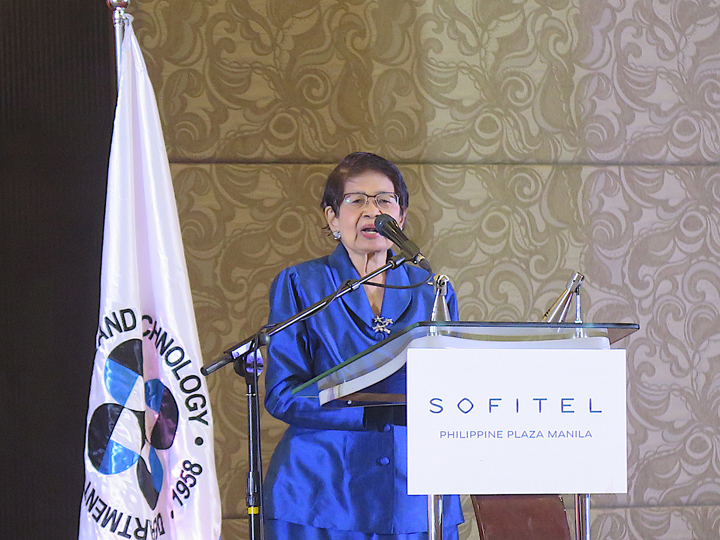
He also acknowledged the full regionalization of the R&D and STI activities of DOST, especially through the Science for Change Program.
He said historically the DOST’s S&T efforts were confined in Metro Manila. But the last three administrations of DOST, including that of de la Peña, went all out to make S&T “felt all over the country.”
He noted the Niche Centers in the Regions Program (Nicer) has 49 universities in 17 regions which implement R&D.
He added that the success of DOST in commercialization of R&D in the countryside is being carried out by Collaborative Research and Development to Leverage Philippine Economy (Cradle) has 39 universities in the regions that collaborate with 87 companies.
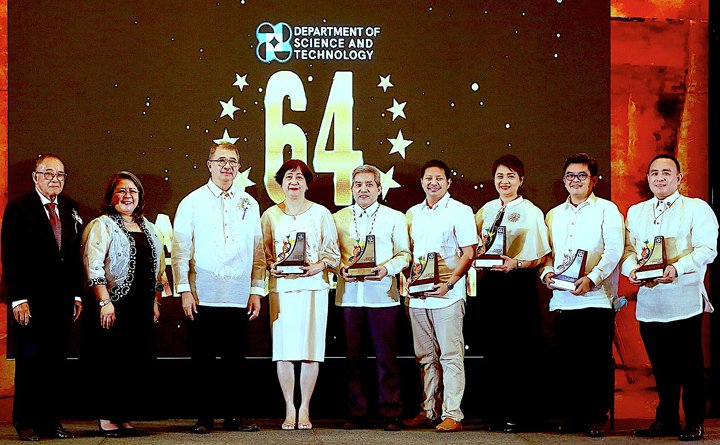
“Nicer and Cradle epitomize the [performance of the] administration of de la Pena,” he said.
Javier also pointed out the jump of the country’s Global Innovation Index from 83 in 2015 to 51 in 2021 out of 132 countries.
“It was a great achievement which we can attribute to the fine work of DOST and its agencies in partnership with other sectors,” he said.
Javier noted that with its achievements, he sees that the performance of DOST under de la Peña “will be treated kindly by history.”
“Your [DOST’s and partners’] competence, dedication, hard work and passion make what DOST is today,” he said.
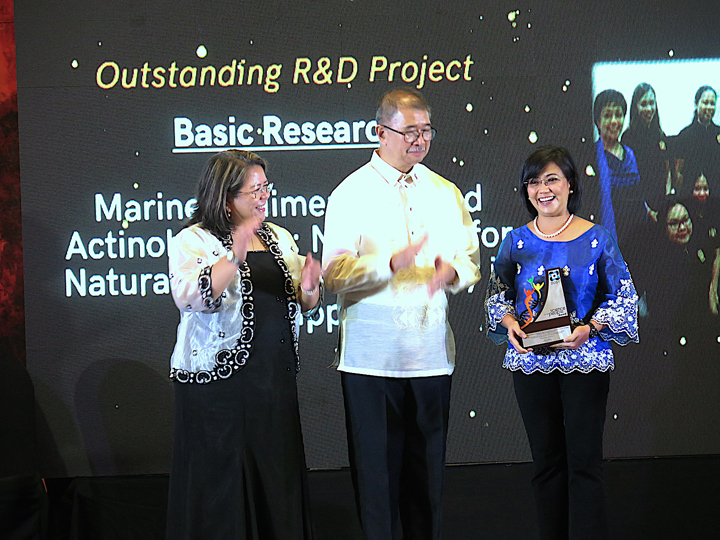
‘Blessed for having worked with DOST, partners’
Delivering his thanksgiving message, de la Peña said he was having “mixed emotions” during the event as he was “happy and excited” seeing familiar faces—his former friends and colleagues at DOST and the partners from the different sectors of society, who have become the DOST’s allies in pursuing its mission.
He said he “was blessed for having worked with all of you,” and being with the DOST “for the most part of my life in government service,” which also made him “feel sad” because this would be his last year of celebrating the agency’s anniversary as its head.
Addressing the awardees, de la Peña said: “Tonight, we acknowledge your great contributions to DOST and to the country as a whole.”
“The plaques and the awards we have given represents not just mere recognition of your invaluable contributions, but along with it is my heartfelt gratitude for many wonderful memories of working with you,” he pointed out.
With the “many milestones” that the DOST had, the challenges and the countless success stories, he said he can “proudly say” that all their “painstaking efforts and sacrifices have paid off.”
“I have nothing but fond memories of all the people I’ve worked with,” he said.

Valuable resources: The people
De la Peña acknowledged that the DOST cannot handle the enormous tasks without the help of its most valuable resources—the people.
“We relied most on the people’s dedication and commitment in doing their work in pursuit of excellence in public service,” he pointed out.
He said the DOST believes that “STI is not just about theories and scholarly publications, nor should it be confined within the walls of laboratories.”
“Rather, we aimed to bring the results of our research and development into practical use to solve problems and in turn, help our people improve their quality of life,” he added.
True to its tagline of “Science for the People,” he said the DOST expanded its reach to benefit more Filipinos across the country, particularly those at the grassroots.
The DOST “made a difference” by using science to empower communities, including those in the far-flung areas by providing them the infrastructure, knowledge and technological interventions to improve their quality of living.
The Science chief pointed out that the department provided the communities with livelihood and technology-based solutions to address rural poverty and difficulties due to geographical isolation. Among them is the Talaandig Indigenous people in Lantapan, Bukidnon.
Veering away from his prepared speech, he said he wanted going around the country to visit the DOST projects because he is happy to hear the feedbacks from stakeholders themselves.
He shared the story of a university researcher, who opted to be an entrepreneur and became a DOST beneficiary.
“She said even if only one government agency is left, if that is the DOST, she would be happy with it,” the Science chief said.
He added that the DOST devoted its efforts to develop the people’s capability to prepare for the future through scholarships for deserving students to help uplift their social and economic conditions.
The DOST was also able to deliver its services to its stakeholders in partnership with local government units, nongovernment organizations, community development groups, academic institutions and national government agencies.
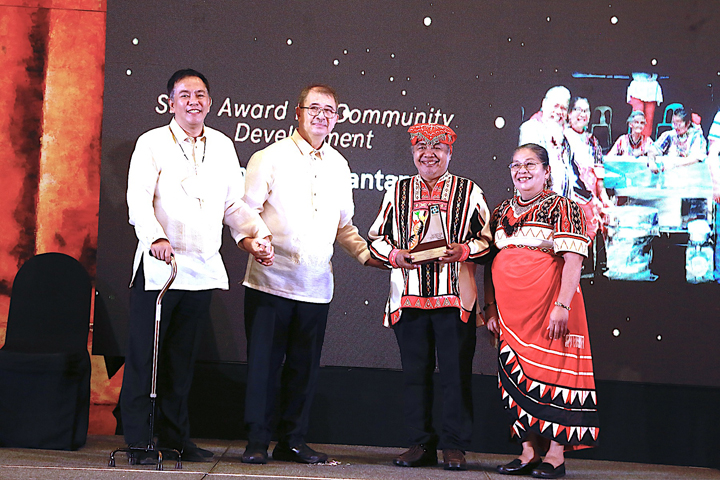
Early pandemic action; international partners
At the height of the pandemic, the DOST was among the first government agencies which worked hard to find solutions against Covid-19.
It actively tried to find ways to gain access to vaccines, treatments and medical supplies through its international partners and foreign counterparts via bilateral and multilateral platforms.
He made special mention of the Vaccine Experts Panel, whose members extended their assistance by sharing their expertise in the vaccine evaluation and selection.
At the same time, the DOST is looking forward to its international partners for their technical expertise, including the country’s “Balik-Scientists” as the country is establishing its Virology and Vaccine Institute of the Philippines.
Through its strong international linkages, the DOST was able to pursue several joint R&D undertakings that helped it “augment the needed expertise not available in the country and improve mobility among our scientists,” de la Peña noted.
Science for Change Program
Under the Science for Change Program, the DOST supported MSMEs, inventors, S&T-based companies, and start-ups through the provision of STI services from technology transfer, financial assistance via capital and equipment, technical assistance through training, and other relevant S&T interventions.
“By helping them, they were able to improve the quality of their products and services, enhance their productivity and learn good manufacturing practices to prepare them to be globally competitive and thereby contribute to the country’s economic growth,” he pointed out.
De la Peña likewise recognized the strong support from policy-makers from Congress who advanced STI by translating the DOST’s programs into laws.
He also gave “importance” to the media by “bringing STI to the people, building science culture among the youth and in delivering timely and accurate information” during national emergencies.
De la Peña did not fail to laud “the much needed support” given by the DOST workers’ respective families, “our loved ones who did their best to understand the way we tried to balance our time and attention in doing what we think is best.”
‘Very devoted, hard working DOST co-workers’
Again veering away from his written speech, he shared that when he asked his family if he will accept President Duterte’s asking him to be DOST chief, his wife replied in the negative, but his children agreed if he could still carry out its functions.
“I thought that if I won’t accept it, I might regret it later,” he said. “But six years have gone by very quickly.”
He lauded his co-workers at the DOST who “are very devoted to work and are hard working.”
“I won’t forget my team at the DOST,” he expressed.
Successes and legacy: Science for the People, by the People
With the DOST’s programs and initiatives on one hand, and all our partners working together, “we believe that our current success will positively impact the country,” he said.
“We will forever be grateful to all of you [partners] for your support and willingness to take part and join us in our efforts in bringing science in the service of our people,” de la Peña pointed out.
He added: “We are starting to see the fruits of our labor in the numerous successful stories of people who availed themselves of our programs and services, innovators that succeeded in their endeavors and made a name for themselves, the people who excel in their fields and gave pride to our country as DOST scholars.”
“All these together with you [DOST partners], I consider DOST’s successes and the legacy that I will pass on to my successor,” he added.
“My heart is full, seeing everyone celebrating this occasion. All of you [DOST co-workers and partners] are instrumental in realizing DOST’s objectives. With your help and utmost support, we are confident that we will attain bigger things for the country in the S&T field,” he said in his written speech.
“I say that indeed, it is Science for the People, by the People,” de la Peña pointed out.
Integrity and passion
DOST Assistant Secretary Leah Buendia, who headed the organizing committee for the event, said the DOST’s service and good relationship with stakeholders and partners is a reflection of their professionalism and expertise.
“We do and implement our programs with integrity and passion to serve the Filipinos. I commend everyone here for their contributions toward sustained commitment in the STI enculturation in both local and international platforms,” Buendia said.
Outstanding SFTP awardees
Academe:
1. Central Luzon State University: Through its collaborations with the DOST-PCAARRD, CLSU was able to cater to 6,828 clients, 44 of whom are start-up incubatees, who have already generated P24.3-million income and 141 jobs from October 2017- April 2022.
2. University of the Philippines: UP’s Philippine Genomics Center’s expansion was funded by the DOST in 2018 for the expansion to Mindanao and Visayas and the upgrading of the center’s R&D capacity through the establishment of the Protein, Proteomics and Metabolomics Facility.
3. De La Salle University: Its partnership with DOST has contributed to DLSU’s standing as the sole private higher education institution in the country to be listed in the Times Higher Education World University Rankings, and also led to the unprecedented 600-percent growth in its research output in the previous decade
Industry:
1. Ephrathah Farms Inc.: As an agri-tourism business in Iloilo, it is engaged in the production of high value fruits and vegetables, and operates as a tourist facility showcasing the different agricultural concerns.
2. Orthopaedic International Inc.: Since its inception, OII has grown into an ISO 13485-certified facility that designs, develops and manufactures orthopaedic products like the Axis Knee Replacement System.
3. Herbanext Laboratories Inc.: With funding support from the DOST’s Business Innovation through Science and Technology Program, the ARIL of Herbanext was founded in 2020, and became the first ever dedicated facility in the country for scaling up the production of standardized herbal extracts and its development into herbal drugs,
Local Government Units:
1. Cauayan City, Isabela: The city has been recognized as the First Smarter City in the Philippines (2015) and later took the lead in localizing the United Nations’ 17-Point Sustainable Development Goals. It was also recognized as the first city in the Philippines to be ISO Certified on ISO 37122 Certification for Sustainable Cities and Communities.
2. Davao de Oro provincial government: With their framework anchored to the Bayanihan 4Ps+, the DOST and Davao de Oro continue to promote and apply Science, Engineering, Technology and Innovation at the grassroots level.
3. Malaybalay City, Bukidnon: Its adoption of DOST-10’s technologies and interventions empowered the LGU to strengthen its Disaster Risk Reduction and Management response, waste management, livelihood creation, and production of high value products.
S&T Foundation:
1. Philippine Foundation for Science and Technology: For 38 years, the PFST continues to promote S&T to the public through its various educational programs. Its flagship program, the Philippine Science Centrum, Traveling exhibits, Teacher’s Training, interactive exhibit development and fabrication and science events have served over 20 million people nationwide.
2. Foundation for the Advancement of Clinical Epidemiology Inc.: FACE serves as the primary support arm of the Department of Clinical Epidemiology of the College of Medicine and the Institute of Clinical Epidemiology of the National Institutes of Health, both based at UP Manila.
3. DLSU Science Foundation Inc.: It assisted DLSU and other De La Salle Philippines’ member district schools through scholarships, professorial chairs, and pure and applied research, and have helped increase DLSU’s annual research publication to about 600 to 700 Scopus listed papers annually.
Media Partners (Institution)
1. BusinessMirror: BusinessMirror has been a partner of the DOST in providing the Filipino people the relevant STI news and information. True to this commitment, the newspaper has its Science Sunday section that is dedicated to stories about breakthroughs in the local science community. It won the Institutional Media Award for Print at the 2018 Bantog Awards.
2. Eagle Broadcasting Network: EBC has been a partner of the DOST in delivering STI news and information to the Filipino people. EBC is the home of NET25 and DZEC Radyo Agila. In 2018, DZEC Radyo Agila won the Institutional Media Award for Radio at the 2018 Bantog Awards.
3. Cable News Network Philippines: CNN Philippines has been among the leading media partners of DOST in disseminating up-to-date science information and news broadcasts. It is the home of Siyensikat, a 30-minute show by the DOST that connects Filipinos to science experts who provide science-based solutions and innovations to uplift their lives.
Media Partners (Individual):
1. Angelina (Lyn) B. Resurreccion: A multi-awarded science journalist since 1995 and as Science Editor of BusinessMirror, she has special interest in the DOST programs and projects on MSMEs, such as SETUP, FilipInnovation and Science for Change Program in order to inform the public about the benefits of STI, and on how the DOST has been providing the technologies and possible cures against Covid-19.
2. Hermelina C. Tenorio: An unrelenting S&T journalist since 1992, she has won several awards, including the Gawad Jose L. Guerrero DOST Media Awards, DOST Hall of Fame Awards and the Ulat Sipag Award.
3. Ma. Cristina C. Arayata: Covering the DOST since 2015 for the Philippine News Agency, she remains a reliable S&T media partner who constantly writes articles and pursues exclusive S&T stories that are of interest to the public, especially during the pandemic.
National Government Agencies:
1. Department of Agriculture, Region 6: To achieve its vision of a food-secured and resilient Philippines with empowered and prosperous farmers and fishers, it collaborates with agencies like the DOST to implement S&T programs and projects.
2. Department of Trade and Industry, Region 8: Some of its collaborations with the DOST are the Technology Business Incubator on Shared Service Facility for Food Processing and activities of the Villaconsuelo Tree Planters Association in Biliran.
3. Office of Civil Defense, Calabarzon: The OCD IV-A is an active partner in promoting and disseminating DOST’s programs, such as on the monitoring of critical government-owned buildings along the Valley Fault System; implementing the Safe, Swift, And Smart Passage Travel Management System; infrastructure audit; and information dissemination and promotion of interventions brought by natural hazards.
Bilateral Partner:
1. United Kingdom: Many achievements were made under the DOST partnership with UK, such as the Synthetic Aperture Radar and Automatic Identification System; the various initiatives under the Newton Agham Program; the Leaders in Innovation Fellowships; the 12 joint health research initiatives; four joint hydrometeorological hazards research; Weather and Climate Science Service Partnership; four Researcher/Institutional Links; and side events in co-hosting COP26.
2. Taiwan: The DOST-Taiwan partnership continuously promotes mutually beneficial collaborative activities in STI under the Agreement on Scientific and Technological Cooperation signed last March 13, 1997.
3. Japan: It has been a consistent bilateral partner of the DOST resulting in meaningful and fruitful collaborations with various Japanese scientific and academic institutions, notably the Japan Space Agency, Japan International Cooperation Agency, Japan Science and Technology Agency, Japan Society for the Promotion of Science, and many others.
Legislator for S&T:
1. Paolo Benigno “Bam” A. Aquino: The former senator, who was the chairman of the Senate Committee on S&T, strongly defended the increase of DOST budget and pushed for the passage of all DOST STI priority bills. This resulted in the enactment of the Republic Act (RA) 11035, Balik Scientist Act; RA 11312, or Strengthening the Magna Carta for Scientists, Engineers, Researchers and Other S&T Personnel; RA 11337, or Innovative Startup Act; RA 11363, or the Philippine Space Act.
2. Erico Aristotle C. Aumentado: As chairman of the House of Representatives’ Committee on Science and Technology in the 17th and 18th Congress, he filed and pushed for the passage of almost all the DOST STI priority bills, including the Balik Scientist Act and the Philippine Space Act.
Nongovernment Organization:
1. Philippine Metrology Standards, Testing and Quality Inc.: It is association advocating for the establishment of a strong national quality infrastructure in the country to support the production of globally competitive products and services.
2. Cagayan de Oro Chamber of Commerce and Industry Foundation Inc.: It is committed to promote and safeguard the business interest of its members and help raise the level of competitiveness through linkages and capacity building initiatives.
3. Davao City Hydrology for Environment, Life and Policy Philippines Network Inc.: As a multi-sectoral network, the role of Davao City HELP is to provide guidance through technical voices and science-based knowledge in water use and management.
R&D Projects:
1. Agriculture, Aquatic and Natural Resources: Synergize Academe-Industry Research Undertaking to Improve Production through Banana Surveillance System—It provides a mobile application that allows early detection of diseases. This project develops a system that minimizes cost disease control.
2. Health: Feasibility Analysis of Syndrome Surveillance Using Spatio-temporal Epidemiological Modeler for LGU Epidemiology Surveillance Unit—FASSSTER is a cloud-based disease surveillance and scenario-based disease modeling tool that was developed and operationalized for use by the national and local government agencies during the Covid-19 pandemic.
3. Industry, Energy, and Emerging Technology: Geospatial Information Management and Analysis Project for Hazards and Risk Assessment in the Philippines (GeoRiskPH)—Through a Cabinet Directive issued in July 2019, the GeoRiskPH Integrated System and the HazardHunterPH were approved to be the national platform for hazards and risk assessment.
4. Basic Research: Marine-sediment Derived Actinobacteria: New Vista for Natural Products Discovery in the Philippines
Technology Commercialization:
1. Juan Algal Paste: Algacon Aquafeeds Manufacturing—AAM is recognized as the first R&D Spin-Off company in Region 6. It was one of the pioneer incubatees of the DOST-PCAARRD-UP Visayas Fisheries Technology Business Incubation Project.
2. Field Implementation of a Locally Developed Diagnostic Kit for the Detection of Covid-19: Manila Health Tek Inc.—Dr. Raul Destura and his Manila HealthTek team that was supported by the DOST, developed the first Philippines-developed GenAmplify Covid-19 RT-PCR Detection Kit.
3. Technology and Market Validation of Universal Structural Health Evaluation and Recording System: Usher—Supported by DOST-PCIEERD, the movement from Mapua University R&D project to commercialization became vital to the realization of Dr. Francis Aldrin Uy’s purpose for Usher.
Startup of the Year:
1. Blitzkrieg Animal Diagnostic Center: It is an incubatee of the Agri-Aqua Technology Business Incubator of CLSU and a startup beneficiary of the PCAARRD Startup Grant Fund program.
2. Pivotal Peak Digital Health Solutions Inc.: It is one of the pioneer startups that was granted funding support under PCHRD’s Startup Research Grant Program. PPDHSI is the exclusive licensee of the UP-developed Community Health Information Tracking System, the longest running electronic medical record in the country.
3. Futuristic Aviation and Maritime Enterprise: It provides reliable, secure, easily deployable and affordable solutions to connect devices for real-time intelligent monitoring and management of resources in maritime, aviation, land transportation, enterprise applications.
Enterprise Productivity:
1. Theo and Philo Chocolate Factory Inc.: It introduced chocolate products with unique traditional Filipino flavors to the world.
2. C and H Cosmetics Industries: Producing all natural and innovation-based cosmetics and home-care products, it continuously paves the way toward becoming industry 4.0-ready and the one of the leading Filipino companies with international and local recognitions and accreditations.
3. Trophy Farm Supplies: The DOST’s S&T interventions to the poultry farm increased its capacity and productivity by at least 100 percent.
Community Development:
1. Nagkakaisang Mamamayan ng Legarda Inc. and Jesse V. Robredo Homeowners Association, 3Ws of Barangay 412, Zone 42, Manila: The group welcomed various S&T related interventions provided by DOST-NCR through the DOST’s CEST Program to improve the community’s livelihood and solid waste program, resulting in improved overall living conditions in the community.
2. Municipality of Jabonga, Agusan del Norte: With the introduction of available technologies useful for the communities from the DOST since 2014, Jabonga actively engages in the different technology and skills training and other related activities, empowering specific sectors, particularly the women/housewives and the youth.
3. Municipality of Lantapan, Bukidnon: The Indigenous Peoples from seven tribes of Bukidnon, with agriculture as their major source of livelihood, DOST 10, through PSTC Bukidnon, provided technologies to add more value to their local produce. They also actively engage with the provincial innovation stakeholders to build a more resilient and smarter community while preserving their rich culture and tribal practices.
DOST Governance Innovations:
1. DOST Region IV-B: Innovative Technologies as Solution to Water Security in Mimaropa—The STI interventions have benefitted 1,835 households or at least 9,000 individuals, especially from geographically isolated and disadvantaged areas serving various sectors, including women and Indigenous people.
2. DOST Region VI: S-PASS (Safe, Swift and Smart Passage) Travel Management System—As of April 6, it has reached over 7,457,664 registered users nationwide with 121 or 93.4 percent of LGUs using the system in the issuance of permits of incoming travellers.
3. DOST Region X: Regional Research, Development and Innovation Committee— This innovation-driven network of agencies and institutions composed of eight NGAs, 12 HEIs, seven LGUs, four R&D consortia and four private sector/industry representatives expedited the realization of various innovation initiatives.
Image credits: Bernard Testa, Lyn B. Resurreccion, Henry A. de Leon
Source: https://businessmirror.com.ph/2022/06/19/dost64-confers-science-for-the-people-awards-to-partners/?fbclid=IwAR267YX1ZNDb2l0d5S-srfpkXS8e3senFE66nxm7cuywSWz8rs0s6HzG5yI
